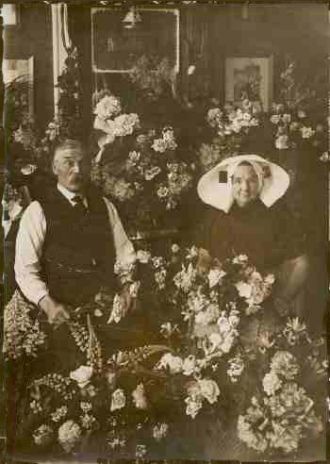Kloosterman Family History & Genealogy
Kloosterman Last Name History & Origin
AddHistory
We don't have any information on the history of the Kloosterman name. Have information to share?
Name Origin
We don't have any information on the origins of the Kloosterman name. Have information to share?
Spellings & Pronunciations
We don't have any alternate spellings or pronunciation information on the Kloosterman name. Have information to share?
Nationality & Ethnicity
We don't have any information on the nationality / ethnicity of the Kloosterman name. Have information to share?
Famous People named Kloosterman
Are there famous people from the Kloosterman family? Share their story.
Early Kloostermans
These are the earliest records we have of the Kloosterman family.


Kloosterman Family Members
Kloosterman Family Photos
Discover Kloosterman family photos shared by the community. These photos contain people and places related to the Kloosterman last name.
Kloosterman Family Tree
Discover the most common names, oldest records and life expectancy of people with the last name Kloosterman.
Updated Kloosterman Biographies


Popular Kloosterman Biographies


Kloosterman Death Records & Life Expectancy
The average age of a Kloosterman family member is 76.0 years old according to our database of 146 people with the last name Kloosterman that have a birth and death date listed.
Life Expectancy
Oldest Kloostermans
These are the longest-lived members of the Kloosterman family on AncientFaces.
Other Kloosterman Records
Share memories about your Kloosterman family
Leave comments and ask questions related to the Kloosterman family.
Followers & Sources

The history begins in France
With the patronage of King Louis VI the Fat, the canons regular built c. 1113 the monastery of St.-Victor in Paris. St. Bernard of Clairvaux helped to shape the rule by which the monks lived, and Bernard, Becket, and Abelard were, at various times, guests of the monastery with great intellectual influence. The Victorines were a small order, but the monastery had many students, and in the XIII Century, it became a college within the University of Paris. In the following century, the monastery began to decline, and in the XV Century, the monks joined the Brethern of the Common Life, founded in Holland.
According to legend, Victor was a soldier in the Roman army at Marseilles when he was hailed before the prefects, Asterius and Eutychius, who sent him to Emperor Maximian for his exhortations to Christians to be firm in their faith in the face of an impending visit by the Emperor. He was dragged through the streets, racked, imprisoned (he converted three guards, Alexander, Felician, and Longinus while in prison). He was again tortured after the guards were beheaded when it was discovered he had converted them to Christianity. When he refused to offer incense to Jupiter, he was crushed in a millstone and beheaded. His tomb became one of the most popular pilgrimage centers in Gaul. His feast day is July 21st.
From the order of St.-Victor in 1246 Wolfaard van Maelstede founded the nunnery "Jerusalem" in Biezelinge in the south -west region of Holland Zeeland on four parcels of land.
During 16th-century iconoclastic fury, in 1572 the nunnery was destroyed, probably by the Geuzen "Dutch protestant rebels" under command of Jerome Seraerts.
Four Victorine nuns survived the slaugther and took refuge somewhere else. They returned in 1578, but the prioress Cathelina Meskens after receiving permission from her Vicar-General sold the remnants. After this the land was leased out.
Those four parcels where called "het clooster" (Cloister).
Kloosterman
literally means in English:
"man from the cloister"
The first name in the Kloosterman history appears around 1550, in the name of Claes and his son Cornelis Jansz. (short fore Janszoon, meaning son of Jan) op 't Clooster (meaning: on the Cloister).
This "Op 't Clooster" can be taken literally, because in an account of Floris van Schaek (1579) the name Jan Claesz comes up as:
"wonende op de stede van 't voorzeide clooster"
which means:
"living on the farm, frontside of the Cloister"
In the neighbourhood of the Cloister there was probably a farm. His descendants (although they did not rented land) were known as Cloosterman and later Kloosterman (around 1750).
In 1583 this was the place where Jan Claesz lived and in 1618 Cornelis Janszoon Op 't Clooster (Cloosterman). He lived and worked those four parcels of land around 1550 - 1580 in Kapelle Biezelinge.
During the 16th and 17th-century the land
where the nunnery once was, kept called:
Den Houck daer 't Clooster in staet"
This means more or less:
"The Land Where The Cloister is".
Later it was called "Cloosterland" and because of this name, the people living on it where called Cloosterman. The name of the land (Kloosterland) disappeared in 1625 but the family name Kloosterman was founded by that time.
Even today the land where the cloister once was, is still easy to locate. In the ground you will still find the stones where the nunnery was build from. These stones are recognised by their colour and surface. The stones have a green glaze surface.
There where more nunneries(cloisters) in Holland due to which families are named Kloosterman today. You don't necessarily have to have your roots in the region Zeeland if your name is Kloosterman.
At the location in Zeeland you will still find a farm with the name "Kloosterhoeve". This farm was occupied by the Kloosterman family for longer times though not constantly.
Take a look at the full genealogy of the Kloosterman family name
at
Cees Kloosterman